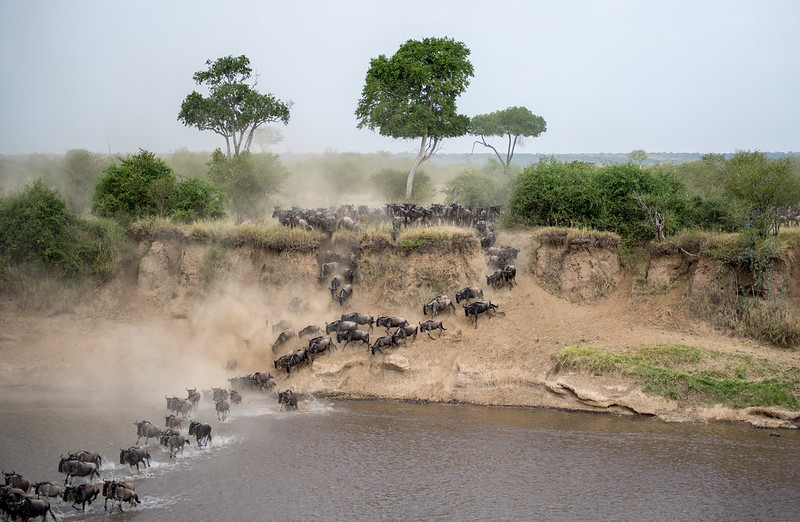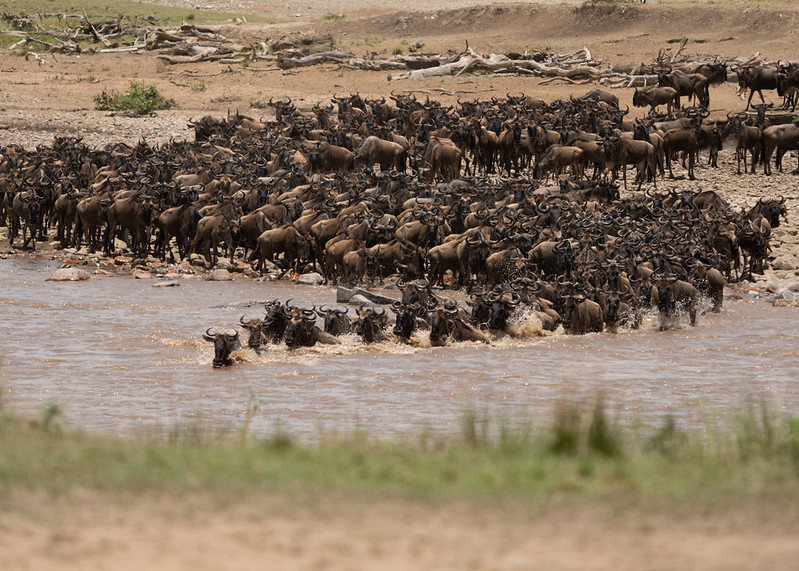The Wildebeests start arriving Kenya in June and by July- August, the entire plains of Mara have been occupied by the wildebeests, zebras and gazelles and its when mara crossing is in progress
Wildebeest Migration In Serengeti
Overview
The Great Wildebeest Migration is a spectacular annual event that takes place in the Serengeti National Park in Tanzania and the Maasai Mara National Reserve in Kenya. It is one of the most renowned wildlife spectacles on the planet, attracting visitors and nature enthusiasts from all over the world.
The migration is a continuous cycle of movement involving millions of wildebeests, zebras, and other herbivores in search of fresh grazing and water.
The animals move in a circular pattern, driven by the changing seasons and the availability of food.
The journey begins in the southern part of the Serengeti, usually around January or February, when calving season starts. Thousands of wildebeest calves are born within a short period, providing a feast for predators like lions, hyenas, and cheetahs.
As the dry season progresses, the herds start moving northwards in search of greener pastures. By June, they begin to gather in large numbers and form huge columns, a sight that is both awe-inspiring and breathtaking.
Around July, the herds usually encounter the Grumeti River, where they face the challenge of crossing safely while avoiding hungry crocodiles lurking in the water. This river crossing is one of the most dramatic and dangerous moments of the migration.
By August and September, the wildebeests, accompanied by zebras and other grazers, cross into the Maasai Mara in Kenya. Here, they graze on the lush plains before starting their journey back to the Serengeti as the short rains begin in October or November.
The exact timing and route of the migration can vary each year, influenced by weather patterns and food availability. It’s crucial to note that the migration is a natural process and is not orchestrated by humans in any way.
The Great Wildebeest Migration is a testament to the marvels of nature and the delicate balance of ecosystems. It provides a unique opportunity for visitors to witness this incredible phenomenon and observe the interconnectedness of life on the African savannah. It’s essential, though, for tourists and travelers to be responsible and considerate while experiencing this event, ensuring minimal disruption to the animals and their habitats.
This event has attracted millions of tourists who come in to witness this great event, at the Mara River infested with crocodiles waiting to pounce of the prey.
The movement involves millions of wildebeests, thousands of Zebras which cross the Mara River in to Masai mara National reserve. These areas are infested with the cheetahs in Serengeti National Park near the Gol mountains at the edge of the Northern part of Ngorongoro Conservation area.
The Serengeti Migration takes place in five areas of the park which offers visitors clear views of animals all year round, such as Seronera, Grumeti River and Ndutu areas among others. The migration alteration movement occurs in different times of the year hence making Serengeti National Park one of the best destinations for wildebeest Migration in Africa.
Below are some of the Guiding information to help you when planning to visit Africa most especially the Masai mara in Kenya and the Serengeti National Park for catch up with the annual wildebeest Migration.

Related Kenya Safaris
Southern Serengeti Wildebeest Migration
The Southern Serengeti wildebeest migration is one of the most remarkable wildlife spectacles that occurs in Tanzania, East Africa. The Serengeti is a vast savannah ecosystem that stretches from northern Tanzania into Kenya, and it is renowned for its abundance of wildlife, including the great wildebeest migration.
The wildebeest migration is an annual cycle that involves the movement of millions of wildebeests, along with other herbivores like zebras and gazelles, in search of fresh grazing and water. This migration is primarily driven by the availability of food and water as the seasons change.
The migration can be broken down into three main phases:
Calving Season which is from December to March; the migration reaches its first phase when the wildebeest herds gather in the Ndutu area and the Ngorongoro Conservation Area. Here, the wildebeests give birth to their young, and the vast plains become a nursery filled with newborn calves. This period attracts predators like lions, cheetahs, and hyenas, as they prey on the vulnerable young animals.
Wet Season (April to May), the rains begin to fall, the lush grasses start to grow, providing abundant food for the wildebeests. During this time, the herds start moving northwards in search of fresh grazing lands. The migration starts to spread out as the animals disperse over a larger area.
River Crossing Season (June to November): The climax of the migration occurs during the dry season when the herds must cross the Grumeti and Mara Rivers in their quest for greener pastures. These river crossings are infamous for their dramatic scenes as wildebeests face crocodile-infested waters and other dangers. Many wildebeests do not survive these perilous crossings, making it a significant spectacle for both tourists and predators alike.
It’s important to note that the exact timing and movements of the migration can vary from year to year, depending on factors such as rainfall patterns and food availability. Therefore, it is always recommended to check with local guides or wildlife experts for the most up-to-date information if you plan to witness this incredible natural phenomenon.
Tourists and wildlife enthusiasts from around the world visit the Serengeti to witness this extraordinary event and experience the untamed beauty of nature. The Southern Serengeti is an essential part of the wildebeest migration, offering a unique opportunity to observe the cycle of life and survival in the wild.

Northern Serengeti Wildebeest Migration
The Serengeti wildebeest migration is one of the most remarkable and awe-inspiring wildlife spectacles on Earth, taking place in the Serengeti ecosystem, which spans across Tanzania and Kenya in East Africa. The migration primarily involves two million wildebeests, along with hundreds of thousands of zebras and other herbivores, moving in a circular pattern throughout the year in search of fresh grazing lands and water sources.
The migration can be broadly divided into four main phases:
Calving Season (December to March):
This period marks the beginning of the migration cycle. The wildebeests gather in the southern Serengeti plains, which offer nutrient-rich grasses and water essential for calving. As the young calves are born, they join the massive herds, and predators like lions, cheetahs, and hyenas are also drawn to the area to prey on the vulnerable newborns.
Wet Season (April to May):
As the rains begin around April, the herds start moving northwestward and split into smaller groups. They start their journey towards the western corridor of the Serengeti, where they find greener pastures and water sources.
Grumeti River Crossing (May to July):
In this dramatic phase, the wildebeests must cross the crocodile-infested Grumeti River. The crossing is hazardous, and many animals lose their lives to the lurking predators and treacherous currents. However, they brave the dangers to reach the lush grasslands on the other side.
Mara River Crossing (July to October):
The most iconic part of the migration is the Mara River crossing, where the herds must cross the Mara River into Kenya’s Masai Mara National Reserve. The river is home to large populations of Nile crocodiles and hippopotamuses, posing a significant threat to the wildebeests during the crossing. Yet, driven by their instinct for greener pastures, they make the perilous journey.
In October, after spending several months in the Masai Mara, the herds start their return journey as the dry season approaches, and the cycle begins again with the calving season in the southern Serengeti.
The Serengeti wildebeest migration is not only a fascinating natural phenomenon but also plays a crucial role in maintaining the ecological balance of the region. It is a testament to the resilience and adaptability of these remarkable animals and a bucket-list-worthy experience for wildlife enthusiasts and photographers from around the world.
Best Time To Visit
When to visit Serengeti for wildebeest migration
The timing for wildebeest movement is not guaranteed although, the park can be visited all year round depending on when you would like to plan your safari visit in Serengeti National Park. The park covers a vast area of land and offers wide view for game viewing and great opportunity that you will be at the exact location for the wildebeest migration that is at the Mara River or at Grumenti river.
The Serengeti National Park in Tanzania is an iconic destination known for its vast savannahs and incredible wildlife, particularly the annual Great Migration of wildebeest and other animals. The best time to visit the Serengeti largely depends on what you want to experience during your trip. Here are some considerations for each season:
- Dry Season (June to October):
The dry season is generally considered the best time to visit the Serengeti. It runs from June to October, with July to September being the peak months. During this time, the weather is dry, and the vegetation is sparse, making it easier to spot wildlife. The Great Migration typically occurs around June and July, where millions of wildebeest and other animals move in search of fresh grazing. - Wet Season (November to May):
The wet season in the Serengeti occurs from November to May. This period is divided into two parts: the short rains (November to December) and the long rains (March to May). While wildlife viewing can still be rewarding during the wet season, some areas may become inaccessible due to muddy roads. The landscape is lush and green during this time, and it’s the calving season for the wildebeest, so you might have the chance to see adorable baby animals.
Birdwatching in serengeti time:
If you’re interested in birdwatching, the wet season is an excellent time to visit. Many migratory bird species visit the Serengeti during this time, and the birdlife is abundant and vibrant.
Ultimately, the best time to visit the Serengeti depends on your preferences and priorities. If witnessing the Great Migration is your primary goal, aim for the dry season from June to October. However, if you want to experience a greener landscape and see newborn animals, consider visiting during the wet season from November to May.
Request Quote
Fill in and send the safari request form, we shall respond as soon as we receive your message.
You can also reach us on Whats-app Number: +256753750983 for urgent requests.
Tour Highlights
- Day 1: Transferring from Nairobi to the Lake Nakuru
- Day 2: Lake Nakuru to Masai Mara National Reserve
- Day 3: A Full day in the Masai Mara
- Day 4: Transfer back to Nairobi
Why Book This Tour?
- Tour can depart on any day of the week.
- Tour can be customized
- Transportation in Landcruiser or minivan with pop-up for game viewing
- Suitable for solo travelers
Kenya National Parks
Masai Mara National Reserve
Read Our Reviews





